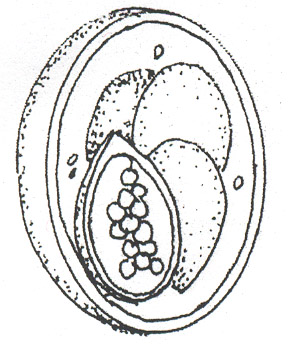Eimeria scapani Henry, 1932
Type host: Scapaus latimanus (Bachman, 1842), Broad-footed mole.
Other hosts: Probably none, see Remarks.
Type locality: NORTH AMERICA: USA, California, near Berkeley.
Geographic distribution: NORTH AMERICA: USA, California.

Description of oocyst:
Oocyst shape: subspheroid;
number of walls: 1;
wall thickness: ~1.0;
wall characteristics: thin, smooth;
L x W: 19.2 x 16.0 (16-22 x 14-16);
L/W ratio: 1.0;
M: absent;
OR: absent;
PG: "several small granules".
Distinctive features of oocyst: none.
Description of sporocysts and sporozoites:
Sporocyst shape: ovoid, pointed at one end;
L x W: not given;
L/W ratio: unknown;
SB: present;
SSB: present;
PSB: absent;
SR: present;
SR characteristics: numerous large granules;
SP: not visible in the photomicrograph.
Distinctive features of sporocyst: pointed end with large granules.
Prevalence: 1/2 (50%).
Sporulation: Exogenous. Oocysts sporulated in 5 days, presumably at room temperature.
Prepatent and patent periods: Unknown.
Site of infection: Unknown. Oocysts recovered from feces and intestinal contents.
Materials deposited: None.
Remarks: The oocysts of this species were not adequately described by Henry (1932) who did not, for example, give measurements or a detailed description of the sporocysts; but she did present a photomicrograph of a sporulated oocyst showing the pointed nature of one end of the sporocysts. Tanabe (1938) said he found this species in the intestinal epithelium of Mogera robusta (=M. wogura) from Japan, in which he said oocysts were 16-21 x 13-15. However, the 2/26 moles from which most of his conclusions were made had "considerable numbers of asexual as well as sexual stages of [at least 2?] Eimeria species together with those of C. caryolytica." It is confounding, at best, to understand how one can look at tissue sections of endogenous stages of coccidia, in which the correct sequence and structure of the stages is not previously known for any of the presumed 3 species present, and conclude which merogonous stage leads to which gamogonous stage, without knowing the sequence of events in single species infections first. Also, because coccidia only rarely cross generic boundaries and because Scapanus and Mogera do not share a recent common ancestor, it is unlikely that the form reported by Tanabe (1938), and the endogenous stages he attributed to it, was of the same species first seen by Henry (1932).
References: Henry (1932); Tanabe (1938).

